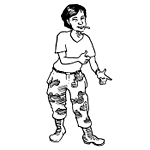Better send a begging letter to the big investigation:
Who put these fingerprints on my imagination?
—Elvis Costello, “Green Shirt”
1.
In a slum outside Rio de Janeiro, a gang of gun-toting drug dealers chases a runaway chicken. Meanwhile, a studious boy who grew up with them walks through the same neighborhood, having recently become a photographer for a city newspaper. Suddenly their paths intersect: the boy freezes, camera dangling from his neck; the dealers clutch their automatic rifles; he has reason to think they want him dead. But instead they ask to be photographed. As it turns out, they love seeing themselves in the paper. So the boy lifts the camera to his face, the dealers clasp their guns, and he does the shooting.
Or he would have, if the police hadn’t preempted him with their own shots. This is a scene from City of God, a Brazilian film released in the United States in January 2003—around the time President Bush was waging his ad campaign for war in Iraq, and about a year after he’d signed a memo wiggling the U.S. military free of the Geneva Conventions. All this is connected only insofar as the memo (either explicitly or by generating a climate conducive to abuse) emboldened a group of soldiers at Abu Ghraib to exploit what the young photojournalist in Rio learned by accident: a camera is a tool of power—sometimes a match for a whole drug gang, other times just enough against defenseless prisoners of war. The camera’s violence has been a trope of photography criticism for many years, but usually in a metaphorical, postmodern, hedging sort of way. At Abu Ghraib, this metaphor found its skin.
The images of prisoner abuse, captured between October and December 2003, are hideously magnetic because they are as bizarre as they are sexual and violent. There are the relatively straightforward images of cruelty—a soldier winding back his arm as he prepares to pummel a knot of prisoners; or a detainee cornered by an attack dog; or, with a certain flair for narrative, a pair of before-and-after shots that show, first, a naked prisoner with a thigh wound pooling into a red puddle on the concrete floor, and, second, almost the same scene, but on the floor a noticeably larger puddle. And there are the sexual shots—naked prisoners posed in attitudes of fellatio; naked prisoners whose erections are smirked at by a female guard trying to look as macho as possible, with a cigarette hanging from her lips.
But then there are images that coruscate with a sense of the deeply, darkly weird—the prisoner cloaked in a poncho that recalls the KKK,...
You have reached your article limit
Sign up for a digital subscription and continue reading all new issues, plus our entire archives, for just $1.50/month.
Already a subscriber? Sign in





